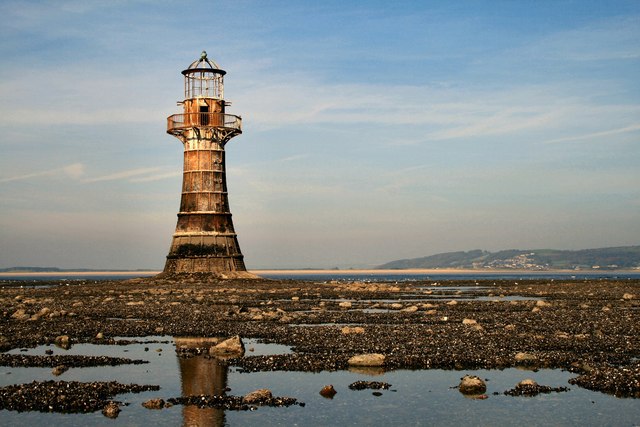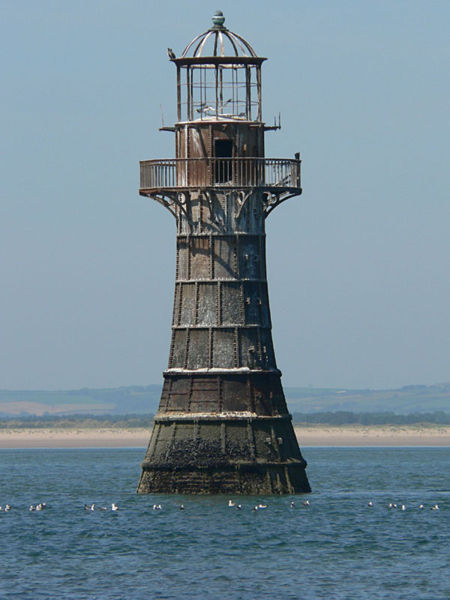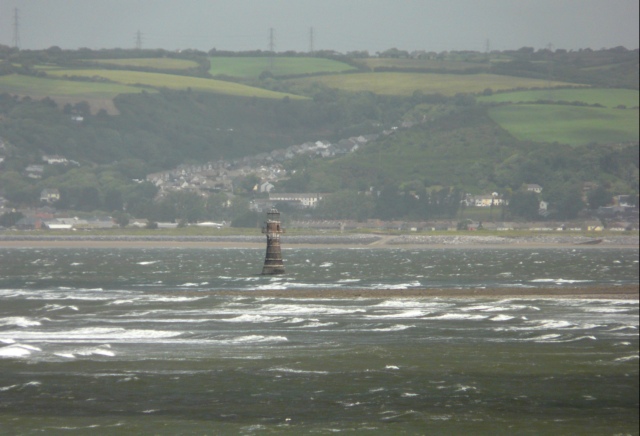Whiteford Lighthouse
aka Whiteford Point
Lighthouse
Gower,
Glamorgan
|

Location Guide |

 Photo by
Martin
Edwards
Photo by
Martin
Edwards

Built in 1865, and remaining in operation until
1937 (another source says 1926).
Thought to be the only remaining sea
washed cast iron lighthouse in the British Isles.
 
 Photo by
Rainer Boettchers
Photo by
Rainer Boettchers


 Photo by
Graham
Taylor
Photo by
Graham
Taylor

Whiteford Point Lighthouse is located off the
coast at Whiteford Point near Whiteford Sands, on the Gower Peninsula, South
Wales.
It has many stories, comes in different sizes
and has a vast number or people interested in it, although for much of its
life its been a wreck abandoned to the sea. Put in any search and you will
find many photos and loads of reports, articles and more, a few I have
selected and linked up further down.
Generally its either 44ft or 61ft high, has a
single room, is made mostly of metal and still looks surprisingly solid
considering the time its been abandoned to the sea. It was last in used in
1987 or 1937 or 1926.
I shall just have to go and investigate it
myself, but for now, I have settled on taking a report principally from
Wikipedia and then adding extra quotes by some others at the end.
So the main article is from an article on
Wikipedia plus some other information from elsewhere.
Whiteford Point Lighthouse
It is an unusual cast-iron lighthouse built in
1865, by the Llanelli Harbour and Burry Navigation Commissioners to mark the
shoals of Whiteford Point, replacing an earlier piled structure of 1854, of
which nothing remains. It is the only wave-swept cast-iron tower of this
size in Britain.
The tower is 44 feet high and stands just
above low-water level. The base is about 24 feet in diameter and rises
gracefully to a diameter of 11 feet six inches at lantern level. Around the
base of the Lighthouse lies a pitched stone apron.
Construction and maintenance
The Lighthouse sits on 88 wooden piles driven into glacial moraine. These
are linked horizontally by walling pieces, using 500 cast-iron plants and
bolts. These would have formed a box, probably square or octagonal, which
would have been excavated and partially filled with concrete. The materials
were delivered by boat and, work undertaken during low tide.
The structure of the shell is formed from 105 bent and tapered cast-iron
plates, each about 32mm thick, with an upstand flange on each side, and
bolted with cast-iron bolts, each weighing 2 lbs. There are eight levels of
panel tapering to the sixth 'course'. The first three horizontal joints are
covered by iron bands supported on brackets and topped with fillets of
concrete.
Throughout the 1870's vertical cracks developed in the plates of the lowest
three rings. A local blacksmith, called Mr Powell, made wrought iron straps,
which were then bolted to the flanges on each side of the cracked plates. At
the time, the cracks were put down to lateral pressures, arising from the
settlement of the inner masonry being composed of rough beach stones and
'bad' mortar. By 1884, 150 straps had been fitted. The compaction of the
fill may have been compounded by movement (swaying) of the tower, reported
in 1884 by the lighthouse keeper to have been 'several inches'. In 1885, the
ground around the tower was strengthened with the addition of a concrete
skirt 18" deep, bound by a 2" wide iron band, effectively anchoring the
skirt to the base of the tower.
The equipment for the Lighthouse is listed in an inventory of 1888 and
indicates that provision was made for two lighthouse keepers, although each
of the census returns of 1871, 1881, 1891, and 1901, name one keeper. The
working pattern was two weeks at Whiteford Lighthouse alternating with two
weeks at Llanelli Harbour Lighthouse.
The lamp
Three Argand lamps and reflectors were fitted, one towards the Lynch Pool or
south channel, one towards Burry Port, and one towards Llanelli. In 1876,
the Harbour Master set a fourth lamp to shine west along the north channel.
The Admiralty chart of 1887 shows the "Arc of Visibility" of the lights from
slightly west of south, through north, to slightly south of east.
The Lighthouse was discontinued in 1920, when responsibility for the light
was transferred to Trinity House, who decided to establish a new beacon at
Burry Holms. However, after pleas from local yachtsmen, the light was relit
in the 1980s. This gave an additional point of reference when navigating the
waters between the Gower Peninsula and Burry Port: on dark nights, boat
crews often found themselves on top of Whiteford Point before realizing the
fact. The cost was £1,300, with £1,000 being funded by the Harbour
Commissioners, and the balance by Burry Port Yacht Club. The new light was
fully automatic and switched on when daylight faded to a pre-determined
level. Two nautical almanacs, published in 1987, Reeds, and Macmillan and
Silk Cut, listed the Lighthouse as flashing every five seconds.
After a failure of the solar unit, the light was removed and not replaced.
However, the Lighthouse still has navigational value in daylight. The
Lighthouse is now owned by Carmarthenshire County Council.
Historical significance
The first known cast-iron British lighthouse was at Swansea Harbour and was
built in 1803. The architect was Jernegan, and the plates were cast at the
Neath Abbey Ironworks.
Cast-iron was also used for the
Maryport
Lighthouse,
 Cumberland, in 1834. In
1836, the lighthouse at the Town Pier, Gravesend, Kent, was built from
cast-iron. In 1842, two cast-iron leading lights were erected at Aberdeen,
with elegant tapering octagonal towers, and a smooth external face. At
Sunderland, another well-known example was built on the pier head in 1856. Cumberland, in 1834. In
1836, the lighthouse at the Town Pier, Gravesend, Kent, was built from
cast-iron. In 1842, two cast-iron leading lights were erected at Aberdeen,
with elegant tapering octagonal towers, and a smooth external face. At
Sunderland, another well-known example was built on the pier head in 1856.
The first 'solid' rock or wave-washed cast-iron tower was erected on the
exposed Fastnet Rock in 1854, but this cracked and was replaced by a masonry
tower in 1904.
In the middle of the nineteenth century, the engineer Alexander Gordon
designed a number of fine cast-iron towers for colonial waters. These were
cast at Pimlico and shipped out to be erected by comparatively unskilled
labour. Some still survive in Jamaica and Bermuda, and a cast-iron tower at
Tiri-tiri, New Zealand, built in 1920, is one of the last in this material.
Whiteford Lighthouse is the only cast-iron lighthouse in Britain which is
wave-washed, although it can be reached on foot at low tide. The remaining
handful of lighthouses of this type stand well clear of the water either on
harbour piers or reefs.
Whiteford Lighthouse is listed by Cadw as Grade II* as a rare survival of a
wave-swept cast-iron lighthouse in British coastal waters, and an important
work of cast-iron architecture and nineteenth century lighthouse design and
construction. It is also a Scheduled Ancient Monument.
The fact that the first known cast-iron British lighthouse (Swansea Harbour,
1803) and one of the last (Whiteford Point, 1865) are close together
geographically is of particular significance in a local context.
Article from Wikipedia information, plus other
information from elsewhere.
Additional information
Engineering timelines  says
says
| It is 61ft high and
made using eight courses of cast iron plates, tapering markedly. These
are bolted through internal and external flanges, and a wrought iron
balcony is bracketed onto the 7th course. Wrought iron strengthening
bands were added some time after construction.
The light was extinguished in 1921
but in 1982 a solar lamp was installed. The harbours of Burry Port and
Llanelli, whose traffic made use of the light, are now largely unused.
At low tide, the tower can be reached on foot but the approach is
treacherous due to quicksand and unexploded shells. |
The-Gower.com
 says
says
Off the end of
Whiteford Point stands an old lighthouse which is now the only cast
iron lighthouse, surrounded by sea in the UK. The approach to the
lighthouse takes quite a while and it appears never to get any closer!
Don't forget to check the tides before you set off.
Parking is in the little village of Cwm Ivy, it is a 15-20 minute walk
through the National Nature Reserve and the sand dunes. There is
always some sand, even at high tide. A haven for ornithologists and
botanists alike |
On a
Photo set
 one photo shows a line of old supports that would have carried a walkway to
the lighthouse
one photo shows a line of old supports that would have carried a walkway to
the lighthouse
On
another this feature is explained.
this feature is explained.
Transportheritage.com
 says
says
| This is an unusual
cast-iron lighthouse built in 1865, by the Llanelli Harbour and Burry
Navigation Commissioners to mark the shoals of Whiteford Point,
replacing an earlier piled structure of 1854, of which nothing
remains. It is the only wave-swept cast-iron tower of this size in
Britain. The tower is 44 feet high and stands just above low-water
level. The base is about 24 feet in diameter and rises gracefully to a
diameter of 11 feet six inches at lantern level. Around the base of
the Lighthouse lies a pitched stone apron.
The Lighthouse sits on 88 wooden piles
driven into glacial moraine. These are linked horizontally by walling
pieces, using 500 cast-iron plants and bolts. These would have formed
a box, probably square or octagonal, which would have been excavated
and partially filled with concrete. The materials were delivered by
boat and, work undertaken during low tide. The structure of the shell
is formed from 105 bent and tapered cast-iron plates, each about 32mm
thick, with an upstand flange on each side, and bolted with cast-iron
bolts, each weighing 2lbs. There are eight levels of panel tapering to
the sixth 'course'. The first three horizontal joints are covered by
iron bands supported on brackets and topped with fillets of concrete.
Throughout the 1870s vertical cracks
developed in the plates of the lowest three rings. A local blacksmith,
called Mr Powell, made wrought iron straps, which were then bolted to
the flanges on each side of the cracked plates. At the time, the
cracks were put down to lateral pressures, arising from the settlement
of the inner masonry being composed of rough beach stones and 'bad'
mortar. By 1884, 150 straps had been fitted. The compaction of the
fill may have been compounded by movement (swaying) of the tower,
reported in 1884 by the lighthouse keeper to have been 'several
inches'. In 1885, the ground around the tower was strengthened with
the addition of a concrete skirt 18" deep, bound by a 2" wide iron
band, effectively anchoring the skirt to the base of the tower.
The equipment for the Lighthouse is
listed in an inventory of 1888 and indicates that provision was made
for two lighthouse keepers, although each of the census returns of
1871, 1881, 1891, and 1901, name one keeper. The working pattern was
two weeks at Whitford Lighthouse alternating with two weeks at
Llanelli Harbour Lighthouse.
The Lighthouse was discontinued in
1920, when responsibility for the light was transferred to Trinity
House, who decided to establish a new beacon at Burry Holms. However,
after pleas from local yachtsmen, the light was relit in the 1980s.
This gave an additional point of reference when navigating the waters
between Gower and Burry Port: on dark nights, boat crews often found
themselves on top of Whiteford Point before realizing the fact. The
cost was £1,300, with £1,000 being funded by the Harbour
Commissioners, and the balance by Burry Port Yacht Club. The new light
was fully automatic and switched on when daylight faded to a
pre-determined level. Two nautical almanacs, published in 1987, Reeds,
and Macmillan and Silk Cut, listed the Lighthouse as flashing every
five seconds. After a failure of the solar unit, the light was removed
and not replaced. However, the Lighthouse still has navigational value
in daylight. The Lighthouse is now owned by Carmarthenshire County
Council.
[edit]Historical significance
The first known cast-iron British
lighthouse was at Swansea Harbour and was built in 1803. The architect
was Jernegan, and the plates were cast at the Neath Abbey Ironworks.
Cast-iron was also used for Maryport Lighthouse, Cumberland, in 1834.
In 1836, the lighthouse at the Town Pier, Gravesend, Kent, was built
from cast-iron. In 1842, two cast-iron leading lights were erected at
Aberdeen, with elegant tapering octagonal towers, and a smooth
external face. At Sunderland, another well-known example was built on
the pier head in 1856.
The first 'solid' rock or wave-washed
cast-iron tower was erected on the exposed Fastnet Rock in 1854, but
this cracked and was replaced by a masonry tower in 1904.
In the middle of the nineteenth century, the engineer Alexander Gordon
designed a number of fine cast-iron towers for colonial waters. These
were cast at Pimlico and shipped out to be erected by comparatively
unskilled labour. Some still survive in Jamaica and Bermuda, and a
cast-iron tower at Tiri-tiri, New Zealand, built in 1920, is one of
the last in this material.
Whiteford Lighthouse is the only cast-iron lighthouse in Britain which
is wave-washed, although it can be reached at foot at low tide. The
remaining handful of lighthouses of this type stand well clear of the
water either on harbour piers or reefs. |
Glamorgan walks
 says
says
|
WHITEFORD LIGHTHOUSE: This
cast-iron lighthouse, the only sea-washed cast-iron lighthouse in the
UK, was built in 1865 with the increase in trade coming from Llanelli
and Burry Port. It marks the South side of the channel to Llanelli
harbour and is located just above low-water mark. The heavy cast-iron
plates which make up the seven rings are bolted together with
external flanges unlike other cast-iron towers which have them
internal. There are copper glazing bars as befits Llanelli's
copper-exporting prominence. Despite its presence, a major shipwreck
took place nearby in 1868. 18 or 19 vessels had been towed out of
Llanelli by steam tugs to proceed by sail. As they rounded Whiteford
Point the wind died and a heavy swell lifted the boats up and down
until their backs broke on the sands. Within an hour 16 of the boats
were total wrecks. It was a quiet night and those ashore were
oblivious to the drama at sea but the morning revealed a scene of
devastation with broken boats and the bodies of sailors lying all the
way from the point to Burry Holms. In 1764, John Wesley, crossed the
estuary on horseback (with a guide!) from around this point and over
to Pembrey |
It was for sale
In 2000, the lighthouse was offered for
sale
 for £1. An
agreement is said to have been reached to restore the tower, but apparently
this agreement collapsed. Later it was reported to be again for sale for £1,
but buyers must prove they have £200,000 available for restoration,
originally it was £100,000. The lighthouse has a single room and cannot be
lived in. for £1. An
agreement is said to have been reached to restore the tower, but apparently
this agreement collapsed. Later it was reported to be again for sale for £1,
but buyers must prove they have £200,000 available for restoration,
originally it was £100,000. The lighthouse has a single room and cannot be
lived in.
|
Lighthouse information Grid
|

|
Please let us know any other information that we
can add to the Grid or page and any errors that you discover. Before making a long trip to any location it is always
wise to double check the current information, websites like magazines may be
correct at the time the information is written, but things change and it is of
course impossible to double check all entries on a regular basis. If you have
any good photographs that you feel would improve the illustration of this page
then please let us have copies. In referring to this page it is helpful if you
quote both the Page Ref and Topic or Section references from the Grid below. To print the
planning grid select it then right click and print the selected area.
Please submit information on locations you discover so
that this system continues to grow.
|